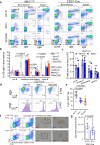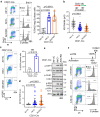ATR kinase supports normal proliferation in the early S phase by preventing replication resource exhaustion
- PMID: 37336885
- PMCID: PMC10279696
- DOI: 10.1038/s41467-023-39332-5
ATR kinase supports normal proliferation in the early S phase by preventing replication resource exhaustion
Abstract
The ATR kinase, which coordinates cellular responses to DNA replication stress, is also essential for the proliferation of normal unstressed cells. Although its role in the replication stress response is well defined, the mechanisms by which ATR supports normal cell proliferation remain elusive. Here, we show that ATR is dispensable for the viability of G0-arrested naïve B cells. However, upon cytokine-induced proliferation, Atr-deficient B cells initiate DNA replication efficiently, but by mid-S phase they display dNTP depletion, fork stalling, and replication failure. Nonetheless, productive DNA replication and dNTP levels can be restored in Atr-deficient cells by suppressing origin firing, such as partial inhibition of CDC7 and CDK1 kinase activities. Together, these findings indicate that ATR supports the proliferation of normal unstressed cells by tempering the pace of origin firing during the early S phase to avoid exhaustion of dNTPs and importantly also other replication factors.
© 2023. The Author(s).
Conflict of interest statement
The authors declare no competing interests.
Figures







Update of
-
ATR kinase supports normal proliferation in the early S phase by preventing replication resource exhaustion.bioRxiv [Preprint]. 2023 May 27:2023.05.26.542515. doi: 10.1101/2023.05.26.542515. bioRxiv. 2023. Update in: Nat Commun. 2023 Jun 19;14(1):3618. doi: 10.1038/s41467-023-39332-5. PMID: 37292881 Free PMC article. Updated. Preprint.
References
Publication types
MeSH terms
Substances
Grants and funding
LinkOut - more resources
Full Text Sources
Molecular Biology Databases
Miscellaneous

